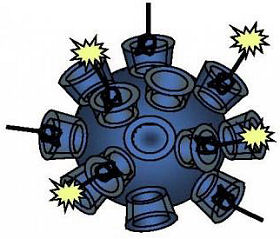22 March 2010
Researchers say results from experimental nanoparticle cancer treatment are "game changing"
by Kate Melville
 A California Institute of Technology (Caltech) led team of researchers has published the first proof that a targeted nanoparticle - injected directly into a patient's bloodstream - can enter into cancer tumors, deliver double-stranded small interfering RNAs, and turn off an important cancer gene using a mechanism known as RNA interference (RNAi).
A California Institute of Technology (Caltech) led team of researchers has published the first proof that a targeted nanoparticle - injected directly into a patient's bloodstream - can enter into cancer tumors, deliver double-stranded small interfering RNAs, and turn off an important cancer gene using a mechanism known as RNA interference (RNAi).
The discovery of RNA interference, the mechanism by which double strands of RNA silence genes, won researchers Andrew Fire and Craig Mello the 2006 Nobel Prize in Medicine.
According to Caltech's Mark Davis, the new findings demonstrate the feasibility of using both nanoparticles and RNAi-based therapeutics in patients, and open the door for future "game-changing" therapeutics that attack cancer and other diseases at the genetic level.
"RNAi is a new way to stop the production of proteins," explains Davis. What makes it such a potentially powerful tool, he adds, is the fact that its target is not a protein. The vulnerable areas of a protein may be hidden within its three-dimensional folds, making it difficult for therapeutics to reach them. In contrast, RNAi targets the messenger RNA (mRNA) that encodes the information needed to make a protein in the first place.
"In principle," says Davis, "that means every protein now is druggable because its inhibition is accomplished by destroying the mRNA. And we can go after mRNAs in a very designed way given all the genomic data that are and will become available."
Until now, one of the potential roadblocks to RNAi therapy has been finding a way to ferry the therapeutics, which are made up of fragile small interfering RNA (siRNAs), into tumor cells after direct injection into the bloodstream. Davis, however, had a solution. Even before the discovery of RNAi, he and his team had begun working on ways to deliver nucleic acids into cells via systemic administration. They eventually created a four-component system that can self-assemble into a targeted, siRNA-containing nanoparticle.
"These nanoparticles are able to take the siRNAs to the targeted site within the body," says Davis. "Once they reach their target - in this case, the cancer cells within tumors - the nanoparticles enter the cells and release the siRNAs." In Davis's Phase I clinical trial, the team was able to detect and image nanoparticles inside cells biopsied from the tumors of several of the trial's participants. In addition, Davis and his colleagues were able to show that the higher the nanoparticle dose administered to the patient, the higher the number of particles found inside the tumor cells - the first example of this kind of dose-dependent response using targeted nanoparticles.
Even better, Davis says, the evidence showed the siRNAs had done their job. In the tumor cells analyzed by the researchers, the mRNA encoding the cell-growth protein ribonucleotide reductase had been degraded. This degradation, in turn, led to a loss of the protein.
"This research provides the first evidence that what works in the lab could help patients in the future by the specific delivery of siRNA using targeted nanoparticles. We can start thinking about targeting the untargetable," notes co-researcher Antoni Ribas.
"At the very least, we've proven that the RNAi mechanism can be used in humans for therapy and that the targeted delivery of siRNA allows for systemic administration," Davis added. "It is a very exciting time."
Related:
Biologists Create Gene "Dimmer Switch"
Prions capable of evolutionary change
Pimp My Retrovirus
Gene Silencing Offers New Strategy For Treating Disease
Zeroing-In On Epigenetic Inheritance Mechanism
Source: California Institute of Technology
